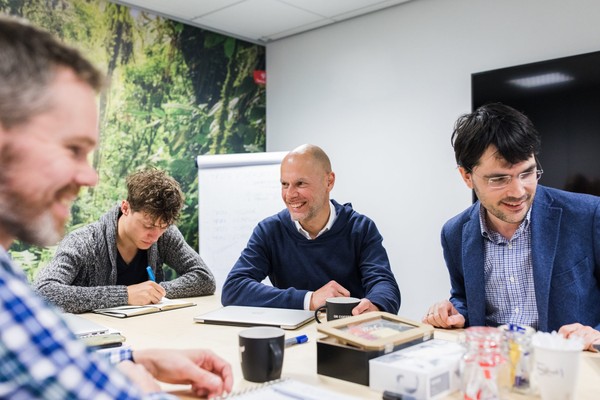cases >> WearM.AI
SENSORS TO MEASURE MUSCLE AND JOINT DATA
SENSORS TO MEASURE MUSCLE AND JOINT DATA
Physical activity is vital to maintain a healthy lifestyle. However, when doing daily outdoor sports, there’s always the risk of injuries. To help people improve their performance and stay injury-free, Huawei Wang developed a wearable technology based on years of research that he turned into the UT spin-off WearM.AI.
This story was first published in the Next Icons Magazine. You can read the entire magazine here.
Your technology collects data to improve sports performance. How is it different from existing wearables like smartwatches?
Huawei: "Very different. I have about ten years of human motion research experience, so I have a clear view of current cutting-edge technology in the field. Our wearable, which you can lace into your running shoes, focuses on muscle and joint level data. That part cannot be detected by smartwatches yet. Those watches usually only measure the number of steps or the speed, but that doesn’t say anything about how you use your muscles or the pressure on your joints. At the same time, that information directly indicates how prone you are to injuries. We offer a simple solution so you can measure your performance without putting 15 sensors on your body. All with the goal of letting people enjoy sports.”
Shortly after you founded your spin-off, we also had a chat, but back then, you wanted to develop smart shoes. Is your add-on prototype a step in between or a pivot?
Huawei: "I believe we pivoted about five times in the past year. Which I believe is a good thing. You see, from a research perspective, a smart shoe sounds really cool. But from a business point of view, it doesn’t make sense. So we decided just to develop the sensors, making our product much more accessible and cheaper. Another pivot we did was our target group. After we decided that our product should be just the sensor, we wanted to focus on the consumers. We came up with many features, such as real-time processing, sharing injury risks, and having a full mobile interface. That turned out to be very complex. On the technology side, we could do it, but it would’ve been too hard to integrate everything all at once. So we came up with a plan to work our way towards the consumer market.”
Can you share what that trajectory looks like?
Huawei: "First, we want to enter the research market. Currently, most research on muscles and joints is done in laboratories. So, test subjects wear multiple sensors and run on the treadmill. However, running outside in the wind and rain on rough terrain is a completely different experience with different risks. Now, researchers lack the technology to conduct research outside the lab, and we provide the solution. Additionally, starting in the research environment will help us to collect a lot of data, which we could use to train our predictive algorithms. So, starting here will provide both the researchers and us with great benefits. After the research market, we want to develop our product for physiotherapists so they can monitor their patients from a distance. It will give an even deeper understanding of outdoor sports. In a sense, we’re bringing sports science back to nature. The development is happening very fast now because we have a clear vision.”
That’s a clear plan for the foreseeable future. How important is innovation in that vision?
Huawei: "Innovation means a lot to me. I could’ve gotten a good job after my post-doc at an R&D department in a big corporation, but I’m too passionate about new technology. I love everything that hasn’t been done before. Currently, AI has massive potential, so I follow the developments closely. It’s also relevant for our product because, with the kinetic data we collect, we aim to build a digital twin of the user. That’s our ambition for the long term. The first step now is to develop our MVP for the research market. We already have ten student employees so the development is going very rapidly. Of course, startup life isn’t always easy. However, knowing I can make an impact on people who want to do outdoor sports means everything to me. Being able to enhance people’s lives through innovation is my driving force to keep going.”
"Knowing I can make an impact on people who want to do outdoor sports means everything to me."
Huawei Wang
CEO WearM.AIMore about
WearM.AI
WearM.AI is a spin-off company from the University of Twente that develops advanced wearable technology that collects muscle and joint data to improve sports performance and prevent injuries. Their sensors, which can be integrated into running shoes, provide deep insight into the biomechanics of running. By starting in the research market and later expanding to physiotherapists and consumers, WearM.AI aims to take sports science beyond the lab. Their mission is to make outdoor sports safer and more effective with innovative technology, driven by a passion for research and AI.






